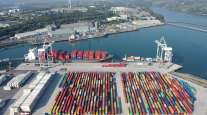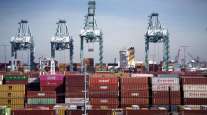Senior Reporter
Nation’s Ports Off to a Strong Start in 2019; Trump Delays Tariff Increase

The nation’s major ports finished 2018 setting monthly and yearly container volume records, and industry experts say 2019 is off to a strong start. Shippers continue to import and export goods as critical trade negotiations between the U.S. and China continue.
“The delay in effective date of the tariffs has continued some inventory buildup beyond the end of the year, that probably would not have happened otherwise,” EDR Group Senior Economist Paul Bingham told Transport Topics. “If the tariffs had gone into effect January 1, that would have slowed some of the shipping, or if there had been a trade deal, where the threat had been removed. But some retailers and some of the other shippers probably were thinking they’ve got another 90-day window to get things onto the distribution center shelves ahead of the tariffs.”
With a deadline looming on the talks with China, President Donald Trump said on Feb. 24 he is delaying the scheduled March 1 increase in the tariffs on $200 billion in Chinese imports. The president said on Twitter he wants to give negotiators more time to reach a comprehensive trade deal with Beijing.
Tariffs on Chinese goods are set to increase to 25% from 10% unless the U.S. and China reach an agreement.
“I am pleased to report that the U.S. has made substantial progress in our trade talks with China on important structural issues including intellectual property protection, technology transfer, agriculture, services, currency, and many other issues. As a result of these very ... productive talks, I will be delaying the U.S. increase in tariffs.”
I am pleased to report that the U.S. has made substantial progress in our trade talks with China on important structural issues including intellectual property protection, technology transfer, agriculture, services, currency, and many other issues. As a result of these very...... — Donald J. Trump (@realDonaldTrump) February 24, 2019
....productive talks, I will be delaying the U.S. increase in tariffs now scheduled for March 1. Assuming both sides make additional progress, we will be planning a Summit for President Xi and myself, at Mar-a-Lago, to conclude an agreement. A very good weekend for U.S. & China! — Donald J. Trump (@realDonaldTrump) February 24, 2019
Trump also announced that he and Chinese President Xi Jinping will hold a summit at Trump’s Mar-a-Lago estate in Florida, “assuming both sides make additional progress.”
Meanwhile, Los Angeles, the nation’s busiest port, is beginning 2019 on an accelerated pace, processing a record 852,000 TEU (20-foot equivalent) containers in January, a 5.4% increase over the same period last year when employees moved nearly 809,000 TEUs.
January marked the seventh consecutive month the port handled more than 800,000 TEUs.
The Port of Los Angeles finished 2018 processing a record 9.45 million TEUs, compared with 9.34 million in 2017.

Seroka
“These robust volumes reflect the pre-Lunar New Year surge of cargo, continued tariff-related inventory advances and strong consumer demand,” Port of Los Angeles Executive Director Gene Seroka said in a statement. “With warehouses and distribution centers already full with spring goods and supplies, we will see softer volumes immediately after the Lunar New Year as anticipated.”
Typically, during the Chinese New Year, shipping activity drops significantly. The Chinese New Year ended Feb. 19.
Shipping experts such as Paul Bingham expect to see a lull in February’s TEU numbers reflecting the holiday, but imports and exports are likely to increase almost immediately.
ICYMI: #PortofLA started 2019 with busiest January ever: Volumes represent a 5.4% jump over January 2018, marking the seventh consecutive month #AmericasPort has handled more than 800,000 TEUs. https://t.co/ld5U9u1r0M pic.twitter.com/ztJ7ybdoHa — Port of Los Angeles (@PortofLA) February 21, 2019
The Port of Long Beach processed nearly 657,300 TEUs in January, down .1% from January 2018 when the port handled 657,800 TEUs.
“It’s encouraging to see these healthy volumes to start the year,” Port of Long Beach Executive Director Mario Cordero said.
Long Beach finished 2018 by setting a record, moving the most cargo in its 108-year history: 8.1 million TEUs compared with 7.5 million in 2017.
The Port of Oakland, the nation’s seventh-busiest facility, processed nearly 209,500 TEUs in January, compared with 205,800 in 2018. For all of 2018 the port moved more than 2.5 million TEUs, compared with 2.4 million in 2017.
2018 was the busiest year in the port’s history.
The Northwest Seaport Alliance, which operates facilities in Seattle and Tacoma, said it finished 2018 on a strong note, processing 349,000 TEUs in December. That is an 11.6% increase over 2017. January 2019 numbers are not available yet. NWSA saw a nearly 100,000-TEU increase for all of 2018, reaching 3.8 million TEUs, compared with 3.7 million TEUs in 2017.
On the East Coast and Gulf Coast, the Port of New York and New Jersey finished 2018 and the month of December in a strong position, processing 610,000 TEUs in December, a 12% increase over 2017’s 543,000. For the year, the port handled nearly 7.2 million TEUs, compared with 6.7 million in 2017. This is the first time in its history the facility exceeded the 7 million-TEU mark. The Port of New York/New Jersey is the third-busiest behind Los Angeles and Long Beach.
The 2018 growth is attributed to the raising of the Bayonne Bridge clearance in 2017 from 151 feet to 215 feet, allowing the world’s largest container ships to pass under it and serve terminals in New York and New Jersey.

(Port of Houston)
The Port of Virginia started January processing 240,000 TEUs compared with more than 220,000 in 2018. For 2018, the facility moved more than 1.61 million TEUs in 2018, the identical number it processed in 2017.
The Georgia Port Authority, which operates the Port of Savannah, moved 430,000 TEUs in January, up more than 90,000 TEUs from 2018’s 339,000. 2018 also closed with a record 4.35 million TEUs, compared with nearly 4.05 million in 2017.
The South Carolina Port Authority said January was a record, up 12.5% from 2018, making it the strongest January ever. The facility handled 205,700 TEUs compared with 167,000 TEUs in 2017. For 2018, the port processed a record 2.3 million TEUs, a 6.3% increase and the third consecutive calendar year of record TEU volume for SCPA.
The Port of Houston also finished on a record note, moving 2.7 million TEUs in 2018, up 10% compared with 2017. January 2019 has seen a slight drop in TEU volume from 221,000 TEUs in 2018 to 215,000 last month.




